Award-Winning Scalp Micropigmentation: A Comprehensive Guide to Choosing the Best SMP Practitioner
Award Winning Scalp Micropigmentation – Hair loss is a common challenge faced by millions of people around the world, and the impact it can have on one’s confidence and self-image is profound. Fortunately, scalp micropigmentation (SMP) offers a revolutionary solution that not only addresses hair loss but also provides a natural-looking, long-lasting result.
However, the success of SMP largely depends on the expertise of the practitioner.
In this guide, we’ll explore everything you need to know about scalp micropigmentation, including its applications, how it compares to other hair restoration methods, and the importance of choosing an award-winning SMP practitioner.
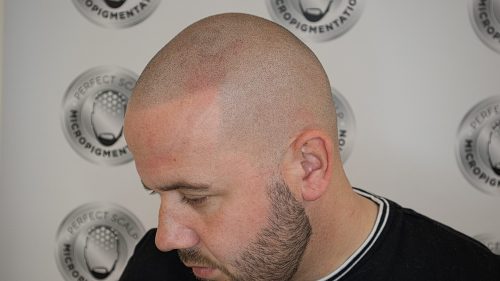
Award Winning Scalp Micropigmentation – What is SMP?
Scalp micropigmentation (SMP) is a non-surgical, cosmetic tattooing procedure where pigments are applied to the scalp using micro-needles. These pigments replicate the appearance of hair follicles, creating the illusion of fuller hair or a closely shaved scalp. The treatment is typically completed over 2-3 sessions, with each session building up the density of the pigment for a more natural and realistic look. Unlike hair transplants, SMP does not involve surgery or the transplantation of hair follicles. Instead, it focuses on creating a visual solution that restores the look of a full head of hair.
Common Applications for Scalp Micropigmentation
SMP is highly versatile and can be used for a variety of hair loss conditions, making it suitable for both men and women:
- Male Pattern Baldness: SMP is a popular choice for men who want to recreate the appearance of a shaved head or buzz-cut look, effectively masking bald spots or receding hairlines.
- Thinning Hair: For those with thinning hair, SMP can enhance the appearance of hair density by filling in gaps and making the hair appear thicker.
- Scalp Scarring: Individuals who have scars from hair transplants, surgeries, or accidents can benefit from SMP as it effectively camouflages scars by blending them into the surrounding hair follicles.
- Alopecia: SMP provides a solution for individuals suffering from alopecia, a condition that causes patchy hair loss. By creating uniform pigmentation across the scalp, it helps restore a balanced look.
- Enhancing Hair Transplants: SMP can also be used in conjunction with hair transplants to improve the appearance of hair density, ensuring a more natural and fuller look.
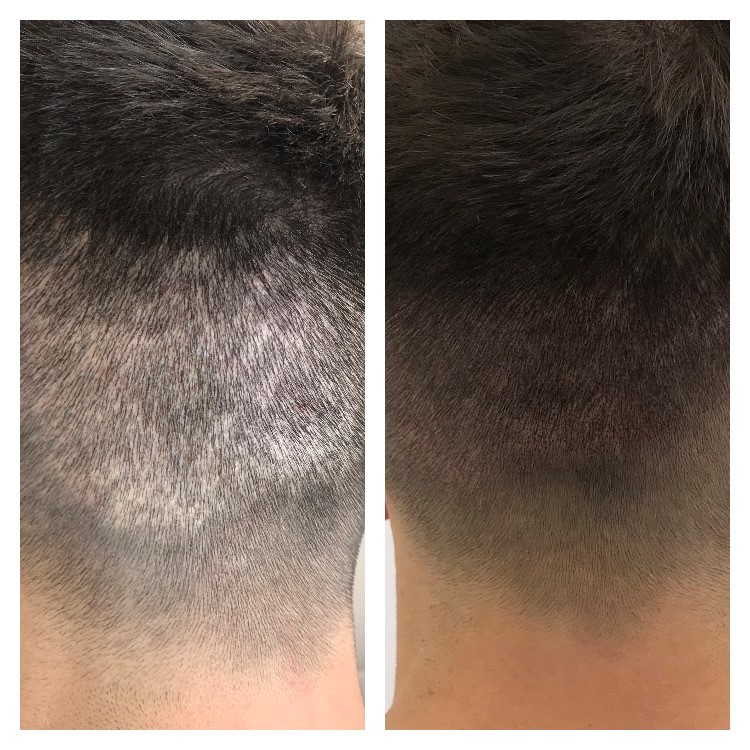
Award Winning Scalp Micropigmentation vs. Hair Transplants
When considering hair restoration options, it’s important to understand the differences between scalp micropigmentation and hair transplants:
How Hair Transplants Work
Hair transplants are surgical procedures designed to move hair follicles from one part of the body, typically the back or sides of the scalp (referred to as the donor area), to areas experiencing thinning or balding (referred to as the recipient area). This technique is often used to treat male pattern baldness, but it can also help with other types of hair loss. There are two main types of hair transplant procedures:
- Follicular Unit Transplantation (FUT):
- Procedure: A strip of skin with hair follicles is surgically removed from the donor area (usually the back of the scalp), and the wound is sutured. The strip is then dissected under a microscope into individual follicular units or grafts. These grafts are transplanted into the balding area.
- Pros: Allows for the transplantation of a large number of grafts in one session, which can be advantageous for those with extensive hair loss.
- Cons: The method leaves a linear scar at the donor site, which may be visible if the hair is worn short.
- Follicular Unit Extraction (FUE):
- Procedure: Individual hair follicles are extracted directly from the donor area using a micro-punch tool. These follicles are then implanted into the recipient area.
- Pros: No linear scar is left behind; instead, there are tiny, dot-like scars, which are less noticeable. The recovery time is typically quicker than FUT.
- Cons: FUE can be more time-consuming, and the number of grafts that can be transplanted in one session is typically lower than with FUT.
How the Procedure is Done
- Consultation and Planning: The surgeon assesses the extent of hair loss and designs a hairline and recipient area pattern that matches the patient’s natural hair growth.
- Anesthesia: Local anesthesia is applied to both the donor and recipient areas to ensure comfort during the procedure.
- Harvesting the Donor Hair: Depending on whether it’s an FUT or FUE procedure, the surgeon will either extract a strip of scalp or individual follicles from the donor area.
- Preparing the Grafts: The hair follicles are dissected and prepared under a microscope to ensure they are healthy and viable for transplantation.
- Implantation: Tiny incisions are made in the recipient area, and the hair follicles are carefully implanted into these incisions, following the natural direction of hair growth.
- Recovery: After the procedure, there is some downtime as the scalp heals. It takes about 2-3 weeks for the transplanted follicles to settle and begin growing new hair.
Drawbacks of Hair Transplants
- Cost: Hair transplants can be expensive, often ranging between £3,000 and £10,000 depending on the extent of the treatment, the surgeon’s expertise, and the geographic location. The cost increases with the number of grafts required, making the procedure inaccessible for some.
- Surgical Risks: As with any surgery, there are potential risks including infection, bleeding, scarring, and poor healing at the donor site. In some cases, there may be a risk of nerve damage, leading to temporary or permanent numbness in the scalp.
- Scarring:
- In FUT, a linear scar is left where the strip of hair-bearing skin was removed. Although the scar can be concealed by hair, it may still be visible if the hair is cut short.
- FUE leaves small dot-like scars that are less visible but may still be noticeable if a lot of follicles are harvested.
- Long Recovery Time: After a hair transplant, it may take several weeks to recover fully. Swelling, scabbing, and soreness are common in both the donor and recipient areas. Full results may take 6-12 months to become apparent as the transplanted hair grows in phases.
- Unpredictable Results: The success of a hair transplant varies based on factors like the quality of the donor hair, the skill of the surgeon, and the individual’s healing process. Some people may not achieve the density they expect, or the hairline may not look as natural as hoped.
- Shock Loss: It’s common to experience “shock loss” after the surgery, where some of the transplanted or surrounding hair falls out within a few weeks of the procedure. While this hair typically regrows, it can be concerning for patients in the short term.
- Not a Cure for Ongoing Hair Loss: Hair transplants do not stop the progression of hair loss. If hair loss continues after the transplant, it can lead to an unnatural appearance, with bald spots appearing around the transplanted area. This may require additional procedures or ongoing treatments like medication (e.g., finasteride or minoxidil) to preserve the results.
- Limited Donor Supply: The success of a hair transplant depends on having enough healthy hair in the donor area. If the donor area is sparse, it limits how much can be transplanted. For people with advanced hair loss, there may not be enough viable donor hair to achieve satisfactory coverage.
- Time-Consuming: Hair transplant procedures can be lengthy, sometimes lasting 8 hours or more. Additionally, several sessions may be required to achieve the desired result, especially in cases of extensive hair loss.
Hair transplants can offer a permanent solution to hair loss by using natural hair, but they come with significant drawbacks such as high costs, surgical risks, scarring, and unpredictable results. Additionally, they require a long recovery time and do not prevent further hair loss, often necessitating additional treatments or procedures.
For those looking for a less invasive, more affordable, and low-maintenance alternative, scalp micropigmentation (SMP) may be a more suitable solution. SMP offers immediate results without surgery, provides a natural-looking appearance, and requires minimal downtime. Unlike hair transplants, SMP can be used to address a variety of hair loss concerns, including thinning, balding, or scarring, with consistent and reliable outcomes. It is an excellent option for individuals seeking a low-risk, long-lasting solution to hair loss without the complexities of surgery.
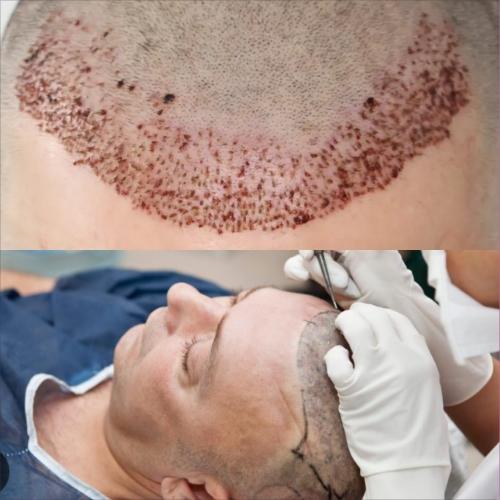
SMP Benefits Summary
- Non-Invasive vs. Surgical: SMP is a non-invasive procedure, while hair transplants involve surgery, where hair follicles are harvested from a donor area and implanted in balding areas.
- Cost: SMP is generally more affordable, with prices typically ranging from £1,000 to £3,500 depending on the extent of the treatment. In contrast, hair transplants can cost between £3,000 and £10,000 or more, depending on the complexity.
- Downtime: SMP has minimal recovery time, allowing clients to return to their daily activities almost immediately. Hair transplants require a longer healing period, often weeks, with swelling, scabbing, and discomfort during recovery.
- Results: SMP provides instant, visible results. Hair transplants, on the other hand, can take several months to show full results as the transplanted hair needs time to grow.
- Maintenance: SMP requires occasional touch-ups every 3-6 years to maintain the pigment’s vibrancy. Hair transplants may need ongoing treatments to address further hair loss.
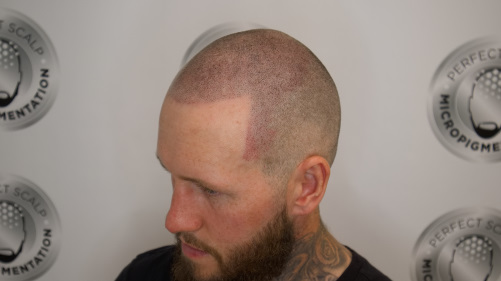
Award Winning Scalp Micropigmentation vs. Hair Systems
Hair systems (wigs, toupees, or hairpieces) are another option for individuals dealing with hair loss. Here’s how SMP compares:
How Hair Systems Work
Hair systems, also known as wigs, toupees, or hairpieces, are non-surgical solutions for hair loss. They consist of a base material (often made from lace, mesh, or polyurethane) that is fitted to the scalp and holds natural or synthetic hair strands. Hair systems can be custom-made to match the wearer’s natural hair color, texture, and density, offering a temporary solution to baldness or thinning hair. Here’s how they work:
- Consultation and Fitting: The process begins with a consultation to assess the individual’s hair loss and design a hairpiece that matches their natural hair. Measurements of the scalp are taken to ensure a precise fit.
- Base Material Selection: The base of the hair system is usually made from breathable materials such as lace, polyurethane, or monofilament, which allows airflow to the scalp. Lace bases are popular for their lightweight and natural appearance, while polyurethane bases are more durable and easier to clean.
- Hair Attachment: Hair systems can use synthetic or natural human hair, and each strand is manually tied or injected into the base. The system is designed to blend seamlessly with the individual’s natural hair.
- Attachment Methods:
- Adhesive or Tape: Most modern hair systems are secured using medical-grade adhesives or double-sided tape, ensuring a firm grip without damaging the scalp.
- Clips: Some systems are attached using small clips that fasten onto the existing hair, offering an easy way to secure and remove the system.
- Bonding: Hair systems can also be semi-permanently bonded to the scalp using a special adhesive that lasts for several weeks before needing reapplication.
- Maintenance and Care: Hair systems require regular maintenance, including washing, styling, and periodic reattachment. Depending on the quality and type of system, they may need professional care every 4-6 weeks. The hair system must be cleaned frequently to maintain its appearance and prevent scalp irritation.
- Replacement: Hair systems need to be replaced periodically, with their lifespan typically ranging from a few months to a year, depending on the material and level of care.
Drawbacks of Hair Systems
- High Maintenance: Hair systems require ongoing care to ensure they remain natural-looking and properly attached. This involves regular cleaning, reapplication of adhesives, and professional servicing.
- Cost Over Time: While the initial cost of a hair system may be lower than surgical options, the long-term costs add up. Hair systems need frequent replacements, and professional maintenance services increase the overall expense.
- Uncomfortable in Certain Conditions: Hair systems can be uncomfortable in hot or humid weather, as the adhesive might weaken, or the scalp might sweat under the system, leading to discomfort or shifting of the hairpiece.
- Natural Appearance: Although modern hair systems can look quite natural, they may still be noticeable, especially if not properly fitted or maintained. There is always a risk of the system moving or becoming dislodged during physical activities.
- Lifestyle Restrictions: Wearing a hair system may limit certain activities like swimming or intense sports, where the system could shift or detach. It also requires constant vigilance to ensure it stays in place throughout the day.
- Psychological Impact: Many individuals may feel self-conscious about wearing a hair system, fearing that it might be noticeable or fall off in public. This can lead to ongoing stress and anxiety.
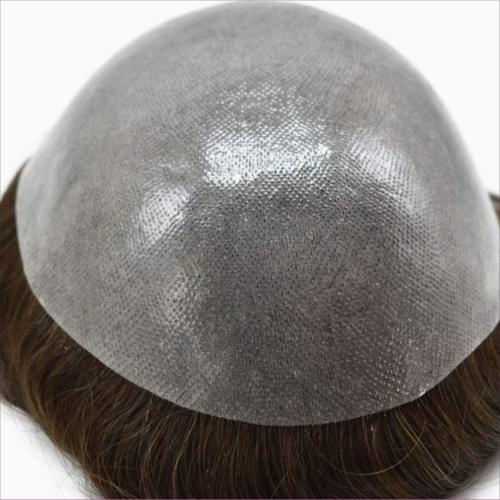
Why Scalp Micropigmentation (SMP) is a Better Alternative
For those seeking a lower-maintenance, more permanent solution, scalp micropigmentation (SMP) presents a superior option over hair systems. SMP offers a natural, long-lasting solution without the daily upkeep and potential discomfort associated with hair systems.
- Permanent Solution: Unlike hair systems that need regular replacement, SMP is a semi-permanent procedure that only requires occasional touch-ups every few years, saving both time and money in the long run.
- Low Maintenance: SMP requires little to no daily maintenance. Once the procedure is complete, there is no need for constant adjustments, cleaning, or professional reapplications.
- Natural Appearance: SMP creates the illusion of hair follicles, giving a natural, closely shaved look that is indistinguishable from real hair. There’s no risk of the appearance shifting or looking unnatural in different conditions.
- Comfort and Confidence: With SMP, there’s no need to worry about adhesives, clips, or the system coming loose during physical activities. This provides greater freedom and confidence in everyday life, especially during sports or swimming.
- Cost-Effective: While SMP has an upfront cost, it is more cost-effective over time compared to continuously purchasing and maintaining hair systems.
- No Lifestyle Restrictions: With SMP, you can enjoy all activities without the worry of a hair system moving or falling out of place. This makes it an ideal choice for active individuals who don’t want to deal with the limitations of hairpieces.
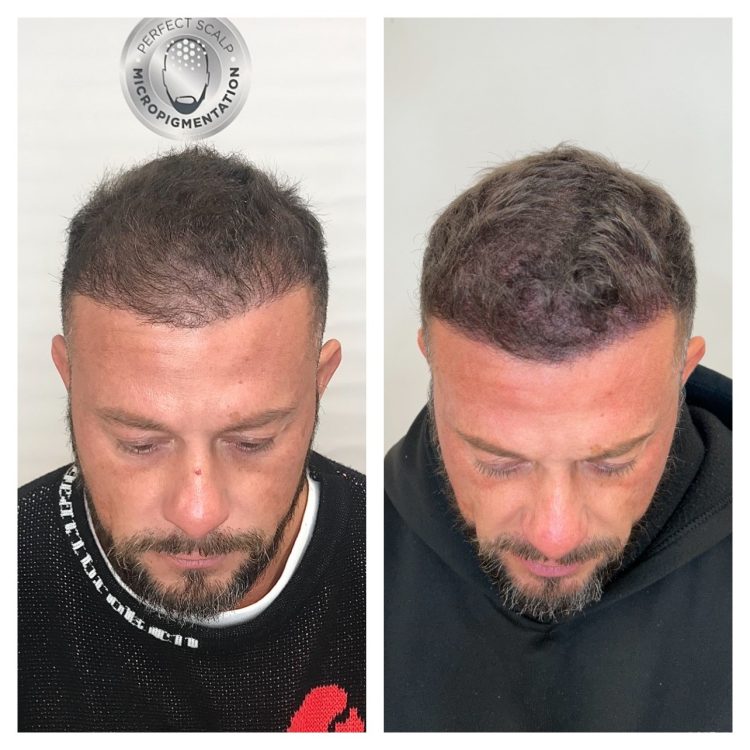
The Importance of Choosing an Award-Winning SMP Practitioner
Scalp micropigmentation is a delicate and intricate procedure, and the quality of your results heavily depends on the skill and experience of your practitioner. This is why choosing an award-winning SMP artist is so important. Awards in the SMP industry are a testament to a practitioner’s expertise, attention to detail, and ability to consistently deliver outstanding results.
Award-winning practitioners, like Rebecca Brown, have undergone rigorous selection processes to be recognized for their excellence in the field. Over her 13-year career, Rebecca has performed thousands of SMP treatments on both men and women of various ethnicities, skin types, and styles. Her unmatched ability to create the most realistic impression of hair has earned her numerous accolades and made her a standout figure in the industry.
Rebecca Brown’s Awards and Achievements
Rebecca’s most recent achievement is winning the Gold Award for Scalp Micropigmentation at the prestigious British Hair and Beauty Awards. This award highlights her exceptional talent, dedication, and consistency in delivering outstanding results for her clients.
The British Hair and Beauty Awards are one of the most esteemed recognitions in the industry, and entrants undergo a rigorous selection process where their work, client feedback, and results are scrutinized by a panel of experts. Only the best practitioners make it to the shortlist, and from there, judges face the difficult task of selecting the best of the best. Winning this award demonstrates Rebecca’s commitment to excellence and her ability to consistently exceed industry standards.
In addition to this prestigious honor, Rebecca has also won awards at the UK Hair & Beauty Awards 2023 and another award in 2021 at the British Hair & Beauty Awards. Her track record speaks volumes about her dedication to her craft and her ability to create exceptional results for her clients. As Rebecca said upon winning the Gold Award:
“I’m absolutely delighted to win this prestigious recognition of my SMP services. I work so hard to ensure my clients get the results they deserve. This award means so much to me, but I can’t do it without my customers—so the biggest thanks go to them.”
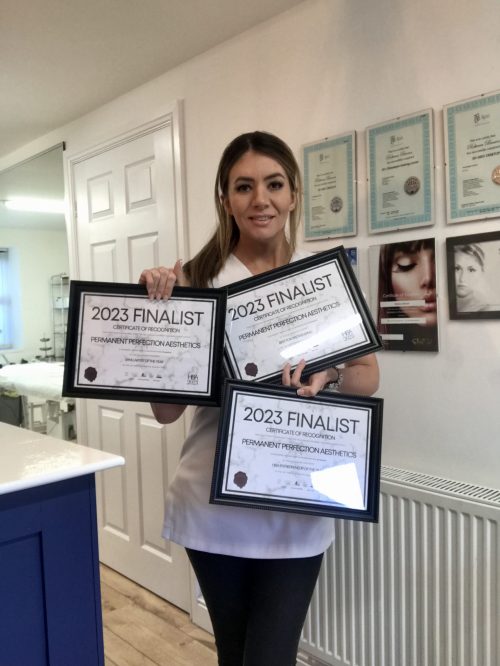
Award Winning Scalp Micropigmentation: How to Choose a Reputable SMP Practitioner
Choosing the right SMP practitioner is crucial for achieving the best results. Here are some key factors to consider:
- Qualifications and Training: Ensure the practitioner has undergone comprehensive training and is certified in SMP techniques.
- Experience: Look for someone with years of hands-on experience and a strong portfolio of successful treatments.
- Specialization: Choose a practitioner who specializes in SMP, as they will have the focus and expertise needed for this specialized procedure.
- Client Reviews and Testimonials: Positive feedback from previous clients can provide valuable insight into a practitioner’s skill and professionalism.
- Consultation Process: A reputable practitioner will offer an in-depth consultation to understand your needs and explain the process clearly.
- Hygiene and Safety: Make sure the practitioner follows strict hygiene protocols and uses sterile equipment.
- Aftercare and Support: A good SMP practitioner will provide detailed aftercare instructions and be available for follow-up support.
Award Winning Scalp Micropigmentation: Common SMP FAQs
- How long does SMP last? SMP can last up to 5-8 years before needing touch-ups, depending on skin type and lifestyle. Over time, the pigments may gradually fade, but the results remain visible for years.
- Is SMP painful? Most clients report only mild discomfort during the procedure, similar to light scratching. Topical numbing agents are typically used to minimize any discomfort.
- How much does SMP cost? The cost of SMP varies depending on the extent of the treatment, but prices typically range between £1,000 and £3,500.
- How many sessions are required? Typically, SMP requires 2-3 sessions, with each session lasting several hours. The number of sessions may vary depending on the desired density and coverage.
- Can SMP be removed? Yes, SMP can be lightened or removed using laser treatments similar to tattoo removal. However, choosing an experienced and skilled practitioner minimizes the need for removal.
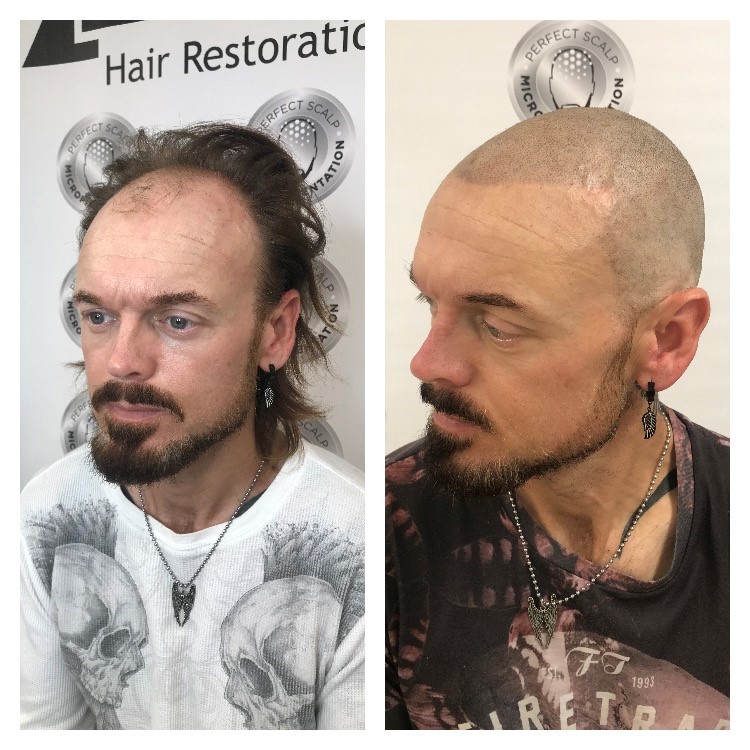
Award Winning Scalp Micropigmentation: Conclusion
Scalp micropigmentation is a game-changing solution for hair loss, offering a natural, long-lasting, and low-maintenance option. However, achieving the best results depends on the expertise of your practitioner. Choosing an award-winning SMP artist like Rebecca Brown ensures that you’ll receive world-class service and results that are nothing short of perfection.
If you’re considering SMP, don’t leave your results to chance. Contact Rebecca Brown at Permanent Perfection Aesthetics today to schedule a consultation and begin your journey to a fuller, more confident look with the help of an award-winning practitioner.


Recent Comments